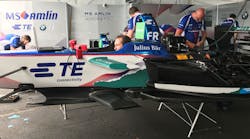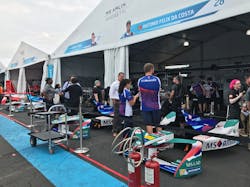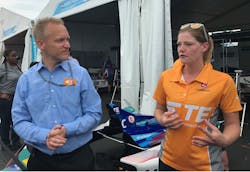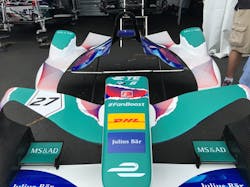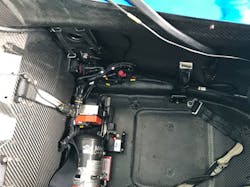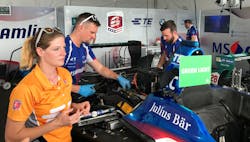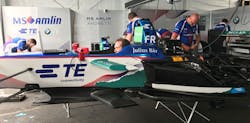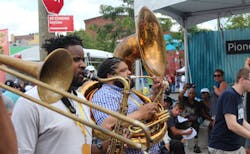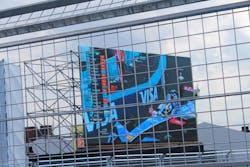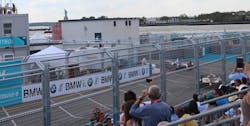Round 9 of Formula-E, the electric street-racing extravaganza, took place in the Brooklyn neighborhood of Red Hook July 15. Being right in my own backyard, I couldn’t miss the opportunity to attend such as interesting event promoting e-mobility.
The New York City Track Map
The circuit in Brooklyn has 10 turns with a length of 1.95 kilometers, where most Formula E cars can accelerate from 0-60 mph in less than three seconds. The course was entirely off-street, ensuring safety and minimizing disruption for the surrounding community. Deputy New York City Mayor Alicia Glen welcomed Formula-E to Brooklyn. “We are about to see some of the greenest, most advanced, and fastest cars on the planet race through the Brooklyn Cruise Terminal, in the heart of one of New York City’s most iconic industrial neighborhoods,” she said. “It’s a showcase of innovation, technology, sustainability—and die-hard competition. What could be more New York?”
The Formula-E Garage
At the garage, every team was making sure their racing cars were ready for Round 9. Andretti’s garage was very busy with a behind-the-scenes tour for the press. For a quick video of the Formula-E garage click here.
Behind the Scenes with TE Connectivity
At Andretti’s garage I met TE Connectivity’s Judith Henzel, resident engineer, Autosport and Paul Webb, Autosport global product manager. They gave me a behind-the scenes tour of the Formula E with an in-depth look at the innovative technologies working within the MS Amlin Andretti race car.
The Structure of Andretti’s Electric Car
According to Webb, from the front of the car to the driver’s seat, the cars are structured pretty similarly to an Indy or a small Formula 1 car. The car is made out of carbon fiber, weighing in at 880 Kg (including the driver). Every car in the race has the same aerodynamics.
The Electronic Control Unit
There is an electronic control unit (ECU) in the cockpit unit that records all the data of what the car is doing. As the name implies, it also controls every electronic function of the car.
TE Sensors and Connectors
Henzel took time to explain the importance of connectors, sensors, and cables inside every MS Amlin Andretti Formula E car. In this picture you can see that the driver’s seat has been removed to show some of the sensors, connectors, and a small battery located in the driver’s seat area. There is an accelerometer, as well as thermal sensors to measure the temperature of the gearbox and pressure sensors to measure the pressure of the oil in the gearbox. The connectors in racing cars are designed for harsh environments and are made especially for easy unplugging. A fire extinguisher is also included.
The Battery Pack and Inverter
The battery pack and the inverter are placed on the back of the car. The battery pack is up to 350-400 Kg, about half the weight of the car. Even though each car gets the same battery, the electric motor, inverter, and gearbox (if the team chooses to have one) are unique to each team. Therefore, a lot can be done to give one’s car an edge. The “Green Light” sign means that at the moment, it is safe to touch the car. There is also a “Blue Light,” which means that the battery is being charged, and a “Red Light,” meaning that something’s wrong. Formula-E keeps pushing for battery efficiency; it predicts that by season 5, drivers will only need one car.
Communication and Cooling Systems
The driver is in constant communication with the team via radio frequency. During each lap the drivers need to know certain data to hit specific energy management numbers. The radiators around the side of the cars help to cool the motor and the battery. There are two completely different cooling systems: one to cool the battery, and the other to cool the motor and electrical system.
Entertainment at the Race
The action in Red Hook started early in the morning, with some practice sessions followed by qualifying sessions. Attendees were entertained with a drivers’ parade, a drivers’ autograph session, and the presence of a jazz band before the actual race took place.
Drivers Changing Cars
Approximately 20 laps into the race, the cars’ batteries started dying, and the drivers made pit stops to change vehicles. In the picture above, it is possible to see the individual cars’ battery status; red means they’re running low.
The Winner of Road 9
It was exciting to see and hear those electric racing vehicles in action. Pictures don’t do the experience justice, so please watch this video and turn the volume up! In this picture above, though, you can see the winner of Road 9: Samuel Bird, a member of the DS Virgin Racing team (purple car).
